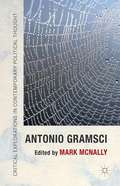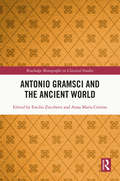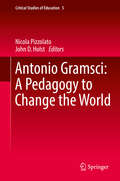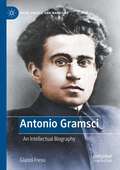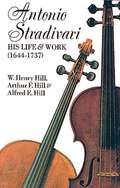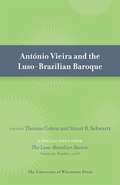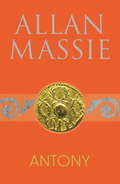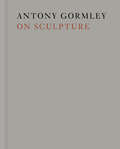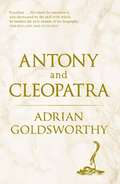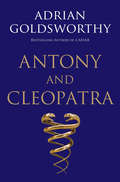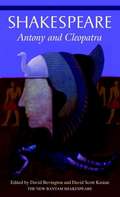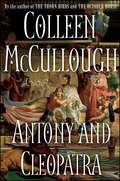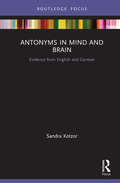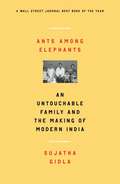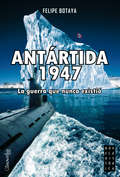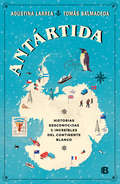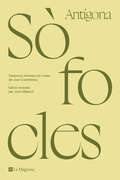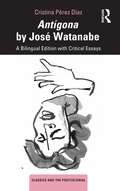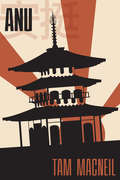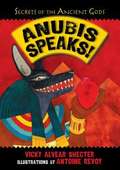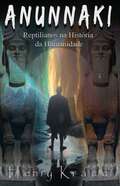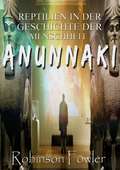- Table View
- List View
Antonio Gramsci (Critical Explorations In Contemporary Political Thought Ser.)
by Mark McNallyThe thought of Antonio Gramsci continues to enjoy widespread appeal in contemporary political and social theory. This book draws together some of the world's leading scholars on Gramsci to critically explore key ideas, debates and themes in his work in an accessible manner, relating them to contemporary politics and society.
Antonio Gramsci and the Ancient World (Routledge Monographs in Classical Studies)
by Emilio Zucchetti Anna Maria CiminoAntonio Gramsci and the Ancient World explores the relationship between the work of the Italian Marxist thinker Antonio Gramsci and the study of classical antiquity. The collection of essays engages with Greek and Roman history, literature, society, and culture, offering a range of perspectives and approaches building on Gramsci’s theoretical insights, especially from his Prison Notebooks. The volume investigates both Gramsci’s understanding and reception of the ancient world, including his use of ancient sources and modern historiography, and the viability of applying some of his key theoretical insights to the study of Greek and Roman history and literature. The chapters deal with the ideas of hegemony, passive revolution, Caesarism, and the role of intellectuals in society, offering a complex and diverse exploration of this intersection. With its fascinating mixture of topics, this volume will be of great interest to students and scholars of classics, ancient history, classical reception studies, Marxism and history, and those studying Antonio Gramsci’s works in particular.
Antonio Gramsci: A Pedagogy To Change The World (Critical Studies of Education #5)
by John D. Holst Nicola PizzolatoThis book is a collection of essays on the educational thought and the pedagogical approach of Italian thinker Antonio Gramsci. Preceded by a broad introduction that positions Gramsci in his context and in the literature, the essays critically revisit the many passages of the Prison Notebooks and pre-prison writings where Gramsci addresses the nexus between politics and pedagogy. Some essays apply those concepts to specific contexts. The book for the first time brings to the attention of an English-speaking audience voices from the current historiography in Italy and Latin America. Overall, the volume provides evidence for the argument of a central place of pedagogy in the interpretation of Gramsci's political theory. Gramsci's view that 'every relationship of hegemony is necessarily a pedagogical relationship' makes it imperative to dismiss narrow and formal interpretations of his educational theories as applying to schooling only. This book argues that what is required rather is an inquiry into the Italian thinker's broad conceptualisation of pedagogy, which he thought as a quintessential political activity, central to understanding and transforming society. Contributors: Stephen Brookfield, Alessandro Carlucci, Diego Fusaro, Flora Hillert, John D. Holst, Carl Levy, Pietro Maltese, Peter Mayo, Riccardo Pagano, Rebecca Tarlau, Andr#65533; Tosel, Mar#65533;a A. Vetter.
Antonio Gramsci: An Intellectual Biography (Marx, Engels, and Marxisms)
by Gianni FresuThis intellectual biography provides an organic framework for understanding Antonio Gramsci’s process of intellectual development, paying close attention to the historical and intellectual contexts out of which his views emerged. The Gramsci in Notebooks cannot fully account for the young director of L’Ordine Nuovo, or for the communist leader. Gramsci’s development did not occur under conditions of intellectual inflexibility, of absence of evolution. However, there is a strong thread connecting the “political Gramsci” with Gramsci as a “cultivated man.” The Sardinian intellectual’s life is marked by the drama of World War I, the first mass conflict in which the great scientific discoveries of the previous decades were applied on a large scale and in which millions of peasants and workers were slaughtered. In all of his theoretical formulations, this dual relation, which epitomizes the instrumental use of “simpletons” by ruling classes, goes beyond the military context of the trenches and becomes full-fledged in the fundamental relations of modern capitalist society. In contrast with this notion of social hierarchy, which is deemed natural and unchangeable, Gramsci constantly affirmed the need to overcome the historically determined rupture between intellectual and manual functions, due to which the existence of a priesthood or of a separate caste of specialists in politics and in knowledge is made necessary. It is not the specific professional activity (whether material or immaterial) that determines the essence of human nature: to Gramsci, “all men are philosophers.” In this passage from Notebooks, we find the condensed form of his idea of “human emancipation,” which is the historical need for an “intellectual and moral reform”: the subversion of traditional relations between rulers and ruled and the end of exploitation of man by man.
Antonio Stradivari: His Life and Work (Dover Books on Music)
by Francis A. Davis W. H. HillLeading appraisers of fine musical instruments agree that in the art of making violins, no one has ever gone beyond the achievement of Antonio Stradivari. The incomparable visual beauty of his instruments and the infinite variety and magnificence of tone of which they are capable have by this time passed into the realm of legend. Collectors have paid many thousands of dollars for one of Stradivari's violins. It is strange, but true, that only one book really delves into the life and art of this famous Italian craftsman. That is the book published in 1902 by the three Hill brothers of the London violin-making firm. Expert violin-makers and critics of superior violin craftsmanship, these men had unique opportunities to examine and compare almost all of the great examples of Italian violin-making.The larger divisions of the book concern the ancestry of Stradivari; his violins, viols, and violoncellos; his aims in relation to tone; his materials; his varnish; his construction; his labels; the number of instruments he made; the growth of their reputation. Some of the topics discussed under these main headings are: Stradivari's apprenticeship to Amati; comparison of his work with that of Amati; the tone of the pre-1684 Stradivari violin; changes between 1684 and 1690; distinguishing characteristics of many existing violins, violas, and cellos, their specific location, etc.; erroneous views concerning Stradivari's material; his preference for the wood of certain trees in given years; the mystery of the ingredients of Stradivari's varnish; the effect of varnish on tone; the measurements of Stradivari's instruments; the time spent by Stradivari in making a violin; the years of greatest production; the largest number dating from one year; estimate of the total number made; an estimate of the actual sum he charged for an instrument; the introduction of Stradivari instruments into France and England; the first revelation of their supreme merit; and many other interesting topics.Musicologists, violinists, makers of instruments, historians of culture, and those who count themselves simply as music lovers will find this to be an extremely interesting and informative account.
Antonio Vieira and the Luso-Brazilian Baroque
by Cohen Thomas Schwartz Stuart B.Preacher, politician, natural law theorist, administrator, diplomat, polemicist, prophetic thinker: Vieira was all of these things, but nothing was more central to his self-definition than his role as missionary and pastor. Articles in this issue were originally presented at a conference, “The Baroque World of Padre António Vieira: Religion, Culture and History in the Luso-Brazilian World,” Yale University, November 7–8, 1997, commemorating the three hundredth anniversary of Vieira’s death.
Antony
by Allan MassieStanding on the verge of ruin, Mark Antony dictates his memoirs to his secretary Critias, who contributes an acerbic running commentary as Antony relives his struggle with Octavian for mastery of the Roman Empire in the wake of Caesar's murder, his infatuation with Cleopatra and his obsession with the East. A tragi-comedy of ambition and self-indulgence, passion and valour, ANTONY forms a triumphant conclusion to Allan Massie's acclaimed Roman Quartet.
Antony Gormley on Sculpture
by Antony GormleyOne of the most exciting sculptors of our time, Antony Gormley is the creator of breathtaking public installations. Even casual fans will recognize Event Horizon, a collection of thirty-one life-size casts of the artist’s body that have been installed atop buildings in places like London’s South Bank and New York’s Madison Square, and Field, formed by tens of thousands of standing clay figurines overflowing across a room’s floor. Projects like these demonstrate Gormley’s ongoing interest in exploring the human form and its relationships with the rest of the material world, and in Antony Gormley on Sculpture, he shares valuable insight into his work and the history of sculpture itself. Combining commentary on his own works with discussions of other artists and the Eastern religious traditions that have inspired him, Gormley offers wisdom on topics such as the body in space, how to approach an environment when conceiving an installation, bringing mindfulness and internal balance to sculpture, and much more. Lavishly illustrated, this book will be of interest to not only art lovers, curators, and critics, but also artists and art students. Dynamic and thought-provoking, Antony Gormley on Sculpture is essential reading for anyone fascinated by sculpture and its long and complex history as a medium.
Antony and Cleopatra
by Adrian GoldsworthyThe epic story of one of the most famous love affairs in history, by the bestselling author of Caesar.*****The monumental love affair between Antony and Cleopatra has been depicted in countless novels, plays and films. As one of the three men in control of the Roman Empire, Antony was perhaps the most powerful man of his day. And Cleopatra, who had already been Julius Caesar's lover, was the beautiful queen of Egypt, Rome's most important province. The clash of cultures, the power politics, and the personal passion have proven irresistible to storytellers.But in the course of this storytelling dozens of myths have grown up. The popular image of Cleopatra in ancient Egyptian costume is a fallacy; she was actually Greek. Despite her local dominance in Egypt, her real power came from her ability to forge strong personal allegiances with the most important men in Rome. Likewise, Mark Antony was not the bluff soldier of legend, brought low by his love for an exotic woman - he was first and foremost a politician, and never allowed Cleopatra to dictate policy to him. In this history, based exclusively on ancient sources and archaeological evidence, Adrian Goldsworthy gives us the facts behind this famous couple and dispels many myths. 'Excellent' Tom Holland'Refreshingly frank' Mary Beard
Antony and Cleopatra
by Adrian Goldsworthy Dr Adrian Goldsworthy LtdThe epic story of one of the most famous love affairs in history, by the bestselling author of Caesar.*****The monumental love affair between Antony and Cleopatra has been depicted in countless novels, plays and films. As one of the three men in control of the Roman Empire, Antony was perhaps the most powerful man of his day. And Cleopatra, who had already been Julius Caesar's lover, was the beautiful queen of Egypt, Rome's most important province. The clash of cultures, the power politics, and the personal passion have proven irresistible to storytellers.But in the course of this storytelling dozens of myths have grown up. The popular image of Cleopatra in ancient Egyptian costume is a fallacy; she was actually Greek. Despite her local dominance in Egypt, her real power came from her ability to forge strong personal allegiances with the most important men in Rome. Likewise, Mark Antony was not the bluff soldier of legend, brought low by his love for an exotic woman - he was first and foremost a politician, and never allowed Cleopatra to dictate policy to him. In this history, based exclusively on ancient sources and archaeological evidence, Adrian Goldsworthy gives us the facts behind this famous couple and dispels many myths. 'Excellent' Tom Holland'Refreshingly frank' Mary Beard
Antony and Cleopatra
by Adrian GoldsworthyThe acclaimed historian reveals the truth behind the myths of antiquity&’s legendary lovers in &“this thoughtful, deeply satisfying&” dual biography (Publishers Weekly, starred review). In Antony and Cleopatra, preeminent historian Adrian Goldsworthy goes beyond the romantic narratives of Shakespeare and Hollywood to create a nuanced and historically acute portrayal of his subjects. Set against the political backdrop of their time, he presents two lives lived at the center of profound social change. It is a narrative that crosses cultures and boundaries from ancient Greece and ancient Egypt to the Roman Empire. Drawing on his prodigious knowledge of the ancient world, and especially the period&’s military and political history, Goldsworthy creates a singular portrait of two iconic lovers who were, in his words, &“first and foremost political animals.&” With a close analysis of ancient sources and archaeological evidence, Goldsworthy explains why Cleopatra was often portrayed as an Egyptian, even though she was Greek, and argues that Antony had far less military experience than popular legend suggests. At the same time, Goldsworthy makes a persuasive case that Antony was a powerful Roman senator and political force in his own right. A story of love, politics, and ambition, Goldsworthy&’s Antony and Cleopatra delivers a compelling reassessment of a major episode in ancient history.
Antony and Cleopatra
by William Shakespeare David Bevington David Scott Kastan James Hammersmith Robert Kean Turner Joseph PappA magnificent drama of love and war, this riveting tragedy presents one of Shakespeare's greatest female characters--the seductive, cunning Egyptian queen Cleopatra. The Roman leader Mark Antony, a virtual prisoner of his passion for her, is a man torn between pleasure and virtue, between sensual indolence and duty... between an empire and love. Bold, rich, and splendid in its setting and emotions,Antony And Cleopatra ranks among Shakespeare's supreme achievements.
Antony and Cleopatra (First Avenue Classics ™)
by William ShakespeareTwo years after the assassination of Julius Caesar in 44 BC, three men—Octavius Caesar, Lepidus, and Mark Antony—rule the Roman Republic. Antony should be in Rome, helping to stop Pompey's rebel army, but he rarely leaves the side of his lover, Egypt's beautiful Queen Cleopatra. With war against Pompey imminent and tensions deepening between Rome's rulers, Antony agrees to marry Caesar's sister as a show of political loyalty. But Caesar has grander plans: he defeats Pompey, imprisons Lepidus, and then turns his sights on Antony. Can Cleopatra and Antony hope to stand against Caesar's powerful navy? A tale of ill-fated romance and warring empires, this is an unabridged version of one of English playwright William Shakespeare's last great tragedies, first performed in 1607 and published in Shakespeare's First Folio in 1623.
Antony and Cleopatra: A Novel
by Colleen McCulloughA sweeping epic of ancient Rome from the #1 bestselling author of The Thorn Birds In this breathtaking follow-up to The October Horse, Colleen McCullough turns her attention to the legendary romance of Antony and Cleopatra, and in this timeless tale of love, politics, and power, proves once again that she is the best historical novelist of our time. Caesar is dead, and Rome is, again, divided. Lepidus has retreated to Africa, while Antony rules the opulent East, and Octavian claims the West, the heart of Rome, as his domain. Though this tense truce holds civil war at bay, Rome seems ripe for an emperor -- a true Julian heir to lay claim to Caesar's legacy. With the bearing of a hero, and the riches of the East at his disposal, Antony seems poised to take the prize. Like a true warrior-king, he is a seasoned general whose lust for power burns alongside a passion for women, feasts, and Chian wine. His rival, Octavian, seems a less convincing candidate: the slight, golden-haired boy is as controlled as Antony is indulgent and as cool-headed and clear-eyed as Antony is impulsive. Indeed, the two are well matched only in ambition. And though politics and war are decidedly the provinces of men in ancient Rome, women are adept at using their wits and charms to gain influence outside their traditional sphere. Cleopatra, the ruthless, golden-eyed queen, welcomes Antony to her court and her bed but keeps her heart well guarded. A ruler first and a woman second, Cleopatra has but one desire: to place her child on his father, Julius Caesar's, vacant throne. Octavian, too, has a strong woman by his side: his exquisite wife, raven-haired Livia Drusilla, who learns to wield quiet power to help her husband in his quest for ascendancy. As the plot races toward its inevitable conclusion -- with battles on land and sea -- conspiracy and murder, love and politics become irrevocably entwined. McCullough's knowledge of Roman history is detailed and extensive. Her masterful and meticulously researched narrative is filled with a cast of historical characters whose motives, passions, flaws, and insecurities are vividly imagined and expertly drawn. The grandeur of ancient Rome comes to life as a timeless human drama plays out against the dramatic backdrop of the Republic's final days.
Antonyms in Mind and Brain: Evidence from English and German (Routledge Focus on Linguistics)
by Sandra KotzorAntonyms in Mind and Brain presents a multi-method empirical investigation of opposition with a particular focus on the processing of opposite pairs and their representation in the mental lexicon. Building on recent cognitive accounts of antonymy which highlight the fundamentally conceptual nature of antonymy, this book outlines previous literature to draw out criteria for good opposites and establish the state of the art on the question whether the strong connection of certain opposite pairs is primarily of a conceptual or lexical nature. presents a detailed cross-linguistic empirical study combining corpus data, speaker judgements and behavioural experiments for a wide range of central (e.g. big:little) and peripheral (e.g. buy:sell; wife:husband) opposite pairs to establish the contribution of individual factors. proposes a model of the representation of opposite pairs in the mental lexicon and illustrates how the processing consequences of such a model account for the patterns observed in the data. The approach taken in this book highlights the importance of using a number of different methods to investigate complex phenomena such as antonymy. Such an approach forms the empirical foundation for a dynamic psycholinguistic model of opposition based on the conventionalisation and entrenchment of the conceptual and lexical relationship of antonyms.
Ants Among Elephants: An Untouchable Family And The Making Of Modern India
by Sujatha GidlaThe stunning true story of an untouchable family who become teachers, and one, a poet and revolutionary <P><P> Like one in six people in India, Sujatha Gidla was born an untouchable. While most untouchables are illiterate, her family was educated by Canadian missionaries in the 1930s, making it possible for Gidla to attend elite schools and move to America at the age of twenty-six. It was only then that she saw how extraordinary—and yet how typical—her family history truly was. Her mother, Manjula, and uncles Satyam and Carey were born in the last days of British colonial rule. They grew up in a world marked by poverty and injustice, but also full of possibility. In the slums where they lived, everyone had a political side, and rallies, agitations, and arrests were commonplace. The Independence movement promised freedom. Yet for untouchables and other poor and working people, little changed. Satyam, the eldest, switched allegiance to the Communist Party. Gidla recounts his incredible transformation from student and labor organizer to famous poet and founder of a left-wing guerrilla movement. And Gidla charts her mother’s battles with caste and women’s oppression. Page by page, Gidla takes us into a complicated, close-knit family as they desperately strive for a decent life and a more just society. <P><P> A moving portrait of love, hardship, and struggle, Ants Among Elephants is also that rare thing: a personal history of modern India told from the bottom up.
Antártida, 1947 (Historia Incógnita)
by Felipe BotayaPocos meses después de acabada la Segunda Guerra Mundial varios submarinos alemanes aparecen sorprendentemente en aguas argentinas. ¿Qué hacían allí después de acabada la contienda? ¿De dónde venían? ¿Cuál había sido su ruta? ¿Qué se esconde detrás de las versiones oficiales de los gobiernos? ¿Por qué todavía hoy sigue siendo materia clasificada?
Antártida: Historias desconocidas e increíbles del continente blanco
by Tomás Balmaceda Agustina LarreaLa Antártida es el lugar más extraño del planeta, la única parte de la Tierra donde los humanos nunca podrían sobrevivir sin ayuda. Este libro presenta un compendio de historias de distintas épocas, proezas de su pasado e interrogantes sobre su futuro. Dos grupos de aventureros se enfrentan en un desafío que les costará la vida: navegar miles de kilómetros para llegar a tierras desconocidas antes que los rivales. Una expedición militar argentina lanza a un perro en paracaídas desde un avión para rescatar a exploradores perdidos en la inmensidad. Una mujer aislada por un crudo temporal decide operarse a sí misma de un tumor. Una supuesta misión científica planta una bandera gigante en la nieve al grito de "¡Heil Hitler!". La enorme extensión de la Antártida parece envolverlo todo: misterios sin resolver, amores, peleas, muertes e historias de superación personal. Tras una exhaustiva investigación, este libro rescata las grandes epopeyas y también las pequeñas historias de quienes se animaron a habitar un territorio tan misterioso como encantador. El resultado es una guía atrapante que recorre el pasado, el presente y el futuro del continente antártico e intenta responder una pregunta: ¿qué secreto envuelve este lugar al que muchos quisieron y siguen queriendo ir sin saber demasiado sobre él?
Antígona
by SófoclesAntígona, de Sòfocles, és segurament l’expressió literària antiga més sublim del conflicte humà entre els dictats de la consciència pròpia i les lleis establertes pels homes. Creont, rei de Tebes, ha prohibit sepultar el cadàver de Polinices, que s’ha alçat en armes contra ell. Antígona, però, la germana de Polinices, el desobeeix. I el seu acte i les conseqüències terribles que comporta també són l’expressió del sacrifici personal a causa d’un convenciment que, en aquest cas, té la raó de ser en la pietat entre germans. Ressenya:«La lluita per una justícia que està per damunt d'unes lleis concretes, la lluita pels drets no escrits, no legislats, però inherents en la persona humana..., aquest és el tema de l’Antígona. I per això és una de les tragèdies gregues més valorades.»De la introducció de Joan Castellanos i Vila
Antígona by José Watanabe: A Bilingual Edition with Critical Essays (Classics and the Postcolonial)
by Cristina Pérez DíazThis book brings to English readers, in its entirety for the first time, a translation of José Watanabe’s Antígona, accompanied by the original Spanish text and critical essays. The lack of availability in English has resulted in the absence of Antígona from important Anglophone studies devoted specifically to the reception of ancient Greek tragedy in the Americas. Pérez Díaz's translation fills this gap. The introduction provides the performative, political, and historical contexts in which the text was written in collaboration with the actress Teresa Ralli, from the Peruvian theater group Yuyachkani, who also originally performed it. Following the bilingual text, a critical essay provides an analysis of textual aspects of Antígona that have been disregarded, situating it in relation to Sophocles' Antigone and in conversation with relevant moments of the vast traditions of reception of the Greek tragedy. An appendix briefly surveys some notable productions of the play throughout Latin America. This comprehensive volume provides an invaluable resource for readers interested in José Watanabe's work, students and scholars working on classical reception and Latin American literature and theatre, as well as theatre practitioners.
Anu
by Tam MacneilJao is in a quandary. He can't find work, and he doesn't want to work for Kazematsuri anyway. That doesn't stop the crazy man from sending new recruits to test their skills on Jao.There is also something going on with Jao's upper class boyfriend, Masahiro. Is he really so busy with his opium business that he struggles to find time for their relationship? Or is he getting tired of slumming it with Jao?Then Kazematsuri turns up in person to employ Jao to find out what a new gang, the Anu, is doing in Okatsu. At the same time Fan, the daughter of his friend Akai, disappears and Akai hires Jao to find her.Now Jao has enough money, but he also has several dangerous people to contend with. And he still needs to find out what's really going on with Masahiro.
Anubis Speaks!: A Guide To The Afterlife By The Egyptian God Of The Dead (Secrets Of The Ancient Gods)
by Vicky Alvear Shecter Antoine RevoyWho better than Anubis, the jackal-headed god of mummification, to serve as a guide through the dreaded Land of the Dead? In this fresh and imaginative approach to nonfiction, the first title in the Secrets of the Ancient Gods series, Anubis steers the reader through the Egyptian dark lands. Along the way, they meet fearsome gods and gruesome monsters. And they witness the battle of the gods against Apophis, the giant demon-snake trying to devour the world. With ghoulish humor and lots of attitude (he is a god, after all), Anubis introduces readers to ancient Egyptian beliefs and rituals—including the secrets of mummification—with panache and, if he does say so himself, drop-dead humor. Includes glossary, bibliography, and index.
Anunnaki: Reptilianos na História da Humanidade
by Mariana Baroni Robinson FowlerMuitas são as culturas que falam da existência dos seres Reptilianos, considerados deuses: os Anunnakis. Há muitas evidências, rastros que esses seres deixaram em nossa história. Os antigos indicaram e representaram esses deuses em suas pinturas, escritos e, acima de tudo, construções, que são impossíveis de se reproduzir em nossa atualidade. Seus conhecimentos tecnológicos e do universo influenciaram nossa história... até os nossos dias.
Anunnaki: Reptilien in der Geschichte der Menschheit
by Robinson Fowler Christine WilhelmViele sind die Kulturen, die uns über die Existenz von Reptilien-Wesen berichten, die als Götter betrachtet werden: Die Anunnaki. Es gibt viele Beweise, Spuren, die diese Wesen in unserer Geschichte hinterlassen haben. Die Alten deuteten und repräsentierten diese Götter in ihren Gemälden, Schriften und vor allem ihren Gebäuden, die in unserer Gegenwart unmöglich zu reproduzieren sind. Sein Wissen, sowohl das technologische als auch das Bewusstsein des Universums, beeinflusste unsere Geschichte ... Bis heute ...

